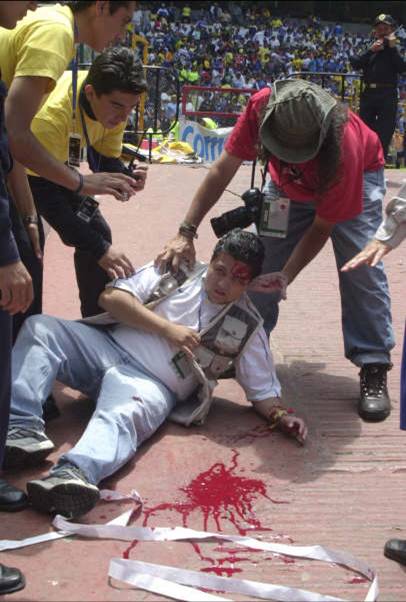
|
The identical phrase was heard in two calls made within a half-hour: “If they insist on publishing (in the newspaper) reports of beheadings, they’re going to end up the same way.”
The two reporters that heard this 10 days ago were at first surprised and worried, then they told their colleagues in the newsroom of the newspaper in a northern Mexico City all about it. Then they went on with their routine.
When threats or warnings are received in newsrooms the internal reaction tends to be slow. In a number of regions in order to be able to carry on working they are often not taken seriously, they are regarded more as a show of bravado.
Reporters, photographers, editors or executives believe in a common phrase and they pretty well use it as justification and live by it: “Those are occupational hazards that go with the job.” To think that way, to say it goes with the job, to take it that way, is a form of self-protection, of trying to hold on to something that can enable them to carry on working. To report under fear would be impossible, and that in a way is why those reporters, like many others in Mexico, grab on to a fictitious immunity when faced with a warning.
Two editors of a newspaper in the north of Mexico were asked five years ago why they did not take precautions for a reporter who received a threat from drug traffickers and who was then kidnapped and disappeared. A laconic reply was: “We didn’t believe anything was going to happen to him, we didn’t think they would dare.”
In a profession in which distrust is a permanent thing that greases the journalist’s nose for news and sets the search for facts in motion, it would seem to be a contradiction that no notice is taken of threats, given the background of so many cases of reporters going missing or murdered in recent years in Mexico. It can only be explained as a new way of surviving, of being able to work, of being able to move on.
Reporters, editors and news media executives constantly take part in courses and workshops that have been necessary to hold in order to provide them with the tools to protect themselves in covering high-risk topics. But this does not appear to be enough. To train 60, 80 professionals a year in the country can be just a drop in the ocean when you take the threats such as those just described into account.
A culture of safety will be needed to be incorporated into every newsroom. And for that what will be required is first to be aware of the risks. Perhaps the level of risk has escalated so much that the universities and journalism schools should take up the matter, including the topic in their courses’ senior year or semester.
“I don’t want to continue learning as I go along,” said a reporter after hearing of the murder of a journalist friend. It is true, up to now a lot has been learned by trial and error, acting by logic to risks of attacks. But one cannot continue on an empirical path when it is known that there have been so many attacks, threats, disappearances or murders of which journalists and news media have been victim.
Occupational hazards exist, but what is happening in Mexico looks nothing like that.

|